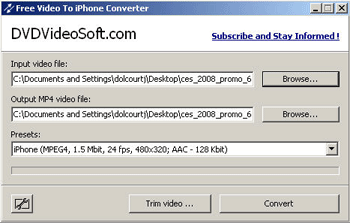If you need to send files to someone and they are too large to email, there are untold numbers of web sites offering this service, both for free and commercially. However, if you need to transfer very big files, your choices are more limited. When I recently needed to transfer some files of 650MB to a client, I tried a handful of these services. Previously I wrote about free services from SendThisFile and EatLime. Here I relate my experiences with the free services from DropSend and TransferBigFiles.

All these services operate by letting you upload files to their servers, notifying the recipient that the files are ready to be downloaded and providing a link that points to the file(s). Some of the services have optional software, but installing software scares me, so I used nothing but a web browser (except in one instance).
DropSend
DropSend offers to send files up to 1 gigabyte for free (the same limit applies to their paid accounts). They allow only five file transfers per month, but also include 250MB of permanent online storage. The limit of five transfers does not apply to uploads to the permanent storage.
Registration is required, they ask for your name, email address and require you to chose a password.
The status display while transfers are in-flight is pretty complete, you see an estimate for the remaining time in minutes, the upload speed and the upload progress both in percent and total megabytes.
A constant annoyance with bandwidth speeds, nothing specific to DropSend, is that they are reported as "bps" and sometimes the "b" stands for bits and sometimes bytes. I emailed DropSend asking if the speed they display is bits/second or bytes/second. I never received a reply.
I didn't like the fact that DropSend opens a new browser window to display the upload status, it crowds the tasksbar. The new window opened despite the fact that Firefox was configured to open new windows in a new tab.
After an upload completes, DropSend tells you the number of megabytes transferred and how long the transfer took. No other service I tried did this.

TransferBigFiles
TransferBigfiles is, according to their website, an "experimental project". The word "BETA" appears in read at the top of each web page. In politics, they call this lowering expectations.
The maximum supported file size is either 1 or 2 gigabytes. In describing their optional software it says "Upload up to 1gb per file". However, in their FAQ it says "TransferBigFiles does not limit the amount of space your account can use on our servers, the only storage limit we have is that your files may not be larger then two (2) gigabytes." Apparently "beta" applies to the documentation too.

A great thing about TransferBigFiles is that neither the sender nor the recipient needs to register. To use the service, as shown above, all you need to do is select a file on your computer and provide an email address for the recipient. It couldn't be any simpler.

While a file is being uploaded, you see the upload speed, an estimate of the time remaining and an estimate of the overall time. For a 650MB file, the initial estimate was 3.14 hours. The first time I tried it however, the upload failed with a Timeout error.
The next day, I tried again to upload a 650MB file and after a while a window popped up with a Timeout error. However, after clicking OK, the upload kept on chugging along. Soon there was another Timeout error and again after disposing of the error window, the upload continued. In all there were a handful of Timeout errors, but the upload completed nonetheless.

The information provided afterwards was disappointing, there were no stats of any type, just a message that the upload worked.
On November 24th, I tried to upload another 650MB file using Firefox and it failed with "The connection was reset - The connection to the server was reset while the page was loading."
About 45 minutes later I tried again using Internet Explorer. This time the upload never even started, after clicking on the start upload button, IE hung and eventually gave up saying it couldn't find the server. I waited about 3 hours, tried yet again and this time too the upload never started.
Thinking maybe they were just having a bad day, I tried again on November 25th. Still, the upload never even started. Instead, Internet Explorer reported that "The page cannot be displayed - Cannot find server or DNS Error".
At this point, I installed their free DropZone client software in a Windows XP SP2 virtual machine. Or rather, I tried to install the software, the install failed with a message that "The application failed to initialize properly".
Not being able to take a hint, I instead researched the software requirements for DropZone. Turns out it needs the .NET framework, an optional component of Windows XP. Specifically, it needs version 2 of the .NET framework, which also comes in versions 1 and 1.1. XP users can check if they have it installed using the "Add or Remove programs" applet in the Control Panel (look for "Microsoft .NET Framework 2.0"). Installing the .NET framework fixed the problem and I was able to install and run DropZone version version 1.1.7.23433.
The website doesn't say it, but to use the DropZone software you have to register for a trial account and provide a valid email address.
I started small with DropZone, transferring an 11K file. Or trying to, this transfer also never started. After waiting a while, I clicked on the Retry button but Windows complained the application was not responding. Task Manager showed it was using 99% of the cpu. I killed it an re-booted.
Next, I tried DropZone with a 1.4MB file. Yet again, the transfer never started. I let it sit for about 30 minutes but still nothing. As before, I right clicked on the file name and click on Retry. Again cpu usage spiked to 100% but the transfer still didn't start.
On November 28th I tried again transferring using the web interface. This time, I was in a different location and using Windows 2000 instead of XP. Despite these changes, the upload again wouldn't start. The error this time was unknown.
Persistence eventually paid off though, shortly thereafter I was able to upload a couple small files. But this turned out to be a waste of time as I sent the file to myself and I never got the notification email informing me that a file was ready to download. After a few hours, I uploaded another file to a different email address of mine. This time the upload failed with the unknown error.
Just for good luck, I tried again late on December 2nd. Again, the upload failed with the unknown error.

Final Thoughts
Despite not being able to transfer a 650MB file, EatLime was, in some ways, the most appealing. There is no registration and thus no password to remember, and, they never learn any email addresses. I was able to send small files with it a number of times. I persisted with TransferBigFiles because it has the simplest user interface, but the many failures speak for themselves. SendThisFile was slow, but reliable (see first posting).
It should go without saying, but never send anything you consider sensitive with any of these services, unless the file is encrypted before it leaves your computer.
Finally, there is another approach altogether, one that cuts out the middle man. You can install software that directly connects two computers over the Internet and lets them transfer files to each other. This approach shouldn't have any inherent limit on file sizes. I didn't try this because the sender and recipient both have to be online at the same time.






























